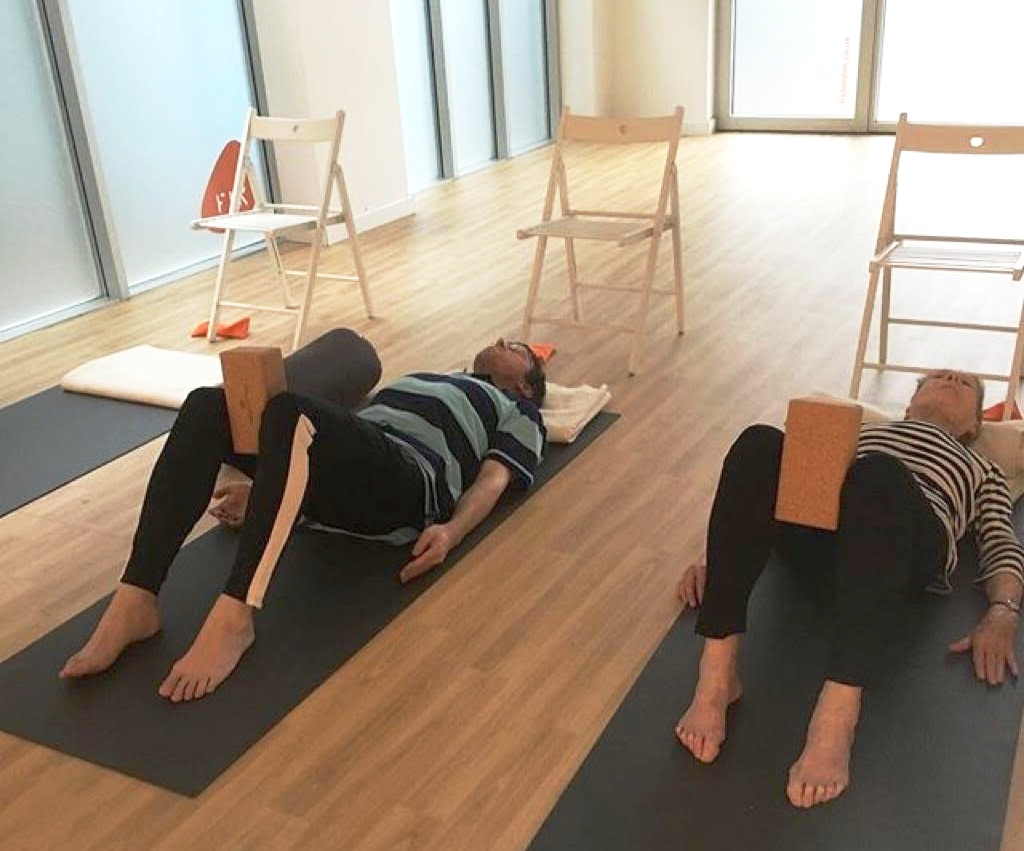by Dr Bryony Hughes, yoga teacher at Fix Studio
Earlier this year, I was invited to teach yoga to a small group of students with Parkinson’s Disease. With my background in medicine and a passion for making yoga accessible to everyone, I jumped at this opportunity. It was been wonderful sharing the practice of yoga with this group. Each week, I learn something new about how the condition impacts on my students’ lives, and together we explore how different practices can help them manage their symptoms. Since moving the class to Fix Studio, I am now looking to expand the class to include students with multiple sclerosis and other progressive neurological conditions.

What are the benefits of yoga?
Practising yoga and mindfulness can give people a sense of control over their body and mind. In Parkinson’s Disease (PD), the uncertainty over how symptoms will change over time can be challenging. Changing how the body feels through breathing and movement practices can give back a sense of self-efficacy.
Postural instability is a hallmark of PD. Yoga improves balance through standing poses (as well as the more advanced arm balances and inversions). Balance poses are modified to the individual with support from a wall or a chair as needed. Practising balance within the safe and supported class environment can help address a fear of falls. Yoga postures help to develop strength, specifically in the lower body, spinal extensors and the core muscles. This is beneficial for postural stability and functional mobility.
Those with PD may face difficulty initiating and controlling voluntary movement such as standing up, walking and sitting down. Yoga involves bringing awareness and attention to movements that automatic in everyday life. It is thought this form of ‘attention retraining’ may help improve functional movement.
Studies have shown a regular yoga practice can improve flexibility and range of motion in the shoulders, hips and spine. This supports people with PD achieving a more upright posture and addressing rigidity.
Yoga can be beneficial for mood and sleep. The practice triggers the ‘relaxation response’, increasing vagal tone and enhancing output from the parasympathetic nervous system. This can alleviate anxiety as well as equipping people to manage stressful situations in everyday life. Improving mood can also be beneficial for motor symptoms. Research has shown that mindfulness can also alleviate low mood and help to manage stress. For those with PD, learning to be present can help with acceptance of a diagnosis as well as living with the daily challenges of the disease.
Studies have shown that the practice of ‘yoga nidra’ is associated with a short-term increase in dopamine levels (Kjaer TW et al, 2002). This suggests that it may be beneficial for those with Parkinson’s Disease where dopamine levels are low.

What to expect from the class?
This is a class specifically for those living with Multiple Sclerosis, Parkinson’s disease and other progressive neurological conditions. It is accessible for different mobilities – Some students use the floor to practice, but the class can also be practised entirely from a chair. Through breath work, physical postures and deep relaxation, the class aims to give inner calm and stillness as well as to help manage symptoms and side effects of medications. It is a safe and supported space to practice yoga and explore what it can do for you.
In the class, you can expect:
To be treated as an individual. Recognising that conditions affect each person differently, the yoga practice will be adapted to your needs on that day.
To feel part of a community. By attending a class, you can meet other people who share some similar challenges and get support from being part of a group. During the class, we practice in silence, but there is an opportunity for discussion at the end.
To begin with relaxation. This may involve a guided body scan meditation, breathing exercises or visualisation. Relaxing can help reduce motor symptoms and allow you to get more from the physical practice.
To learn physical poses (or asana). Yoga postures help develop strength, flexibility and balance. Every pose is modified to the ability of the individual with the use of the wall, chairs and/or blocks for support.
To link movement with the breath. Simple movements are practised with the breath, moving in and out of postures as you breath. It can be easier to control movement in flow rather than longer holds.
To practice mindfulness. Throughout the class, you will be guided on being aware of body sensations and keeping your attention on the present moment. The practice of yoga encourages acceptance, non-judgement and compassion for yourself.
To end with guided relaxation or yoga nidra. Yoga nidra is a deep relaxation practice. This meditative state has been shown to have many benefits for brain function.

Yoga for MS, Parkinson’s Disease and other Neurological Conditions is on Fridays 11am-12pm at Fix Studio, London Fields. For more information, please do get in touch by email (hughes.bryony@gmail.com), I am always happy to answer any questions about the class before you attend.
You can book online here, or check out Bryony’s bio for more details.
